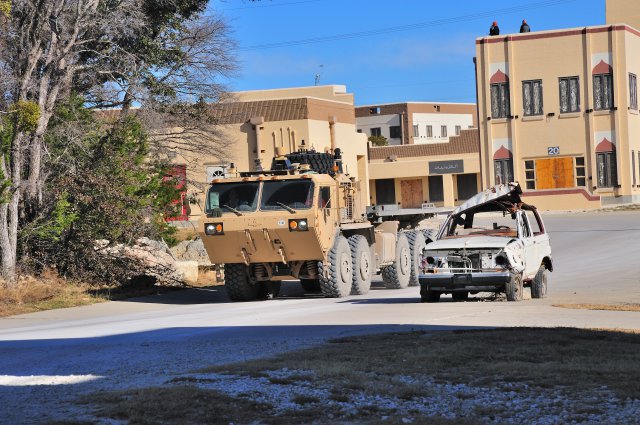Army engineers from the Tank Automotive Research, Development and Engineering Center in Warren, Michigan, are developing technology solutions for autonomy-enabled systems.

TARDEC and an industry partner, Lockheed Martin, demonstrated the Autonomous Mobility Appliqué System, or AMAS at Fort Hood, Texas, in January 2014.
Researchers transformed ordinary trucks from the Army's current vehicle fleet into optionally-manned vehicles, offering drivers new safety features and additional capabilities that never existed until now.
“These systems are designed, not to replace warfighters, but to help unburden them and augment their capabilities,” said Bernard Theisen, TARDEC program manager for AMAS.
By installing kits onto a M915 tractor and two Palletized Loading System prime movers, the driverless trucks were able to negotiate oncoming traffic, follow rules of the road, recognize and avoid pedestrians and various obstacles and autonomously navigate through a maze of test areas.
The trucks were able to complete both complex urban and rural line-haul missions at low speeds.
Engineers challenged the system's capabilities even further by conducting a seven-vehicle unmanned line-haul mission at 40 mph at the Savannah River Site, South Carolina, in May 2014.
During an AMAS Joint Capability Technology Demonstration, or JCTD, held there in August, the addition of Army and Marine drivers engaging in realistic combat scenarios further tested the capabilities of this new autonomy-enabled technology.
“The JCTD demonstrated the flexibility of the system, allowing drivers to choose from a continuum of features and capabilities starting with fully-manned operations; manned-operations with the addition of driver safety features and warnings; and the autonomous leader-follower mode,” Theisen said.
The team also demonstrated additional capabilities such as tethered remote control and remote control operation.
“By delivering technologies that fill top priority capability gaps and improving the current vehicle fleet, our engineers and scientists are helping shape the Army of 2040, and changing the way Soldiers in the next generation will fight,” said TARDEC Director Dr. Paul Rogers. “In today's fiscal environment, the wider lens of a long-range strategy will help the ground vehicle domain remain focused on delivering leap-ahead capabilities to the warfighter and help eliminate unnecessary costs associated with funding delays and periods of continuing resolution. The 30-Year Strategy also serves as a guide to help us choose our collaborative partners and technology investments more wisely.”
TARDEC and its military and industry partners continued to test the capabilities of autonomy-enabled systems in August 2014 at Fort Benning, Georgia, combining unmanned air and unmanned ground vehicles to create a completely new capability to help ease the burden of resupplying Soldiers. In the Extending the Reach of the Warfighter through Robotics demonstration, an unmanned K-MAX helicopter transported an unmanned Squad Mission Support System, or SMSS, ground vehicle via sling load, into a remote area presumed to be dangerous, and dropped it off for a resupply mission.
Using a sophisticated suite of sensors and satellite technology to guide it, the SMSS proceeded to a designated area where it delivered the supplies to the Soldiers who were waiting in the tree line. After completing the mission, the SMSS proceeded by remote control to higher ground, raised its mast and used its Gyrocam to conduct reconnaissance, sending video imagery back to the remote operator in real-time.
“This technology is giving us a greater capability for a resupply and provides us another way of tackling Soldier load,” said Maneuver Battle Lab Deputy Director Eddie Davis. “If we can build a greater confidence level in the Soldiers that we're able to resupply them, they can take only what they need and we can take some of the burden off them.”
TARDEC is also working with industry to develop and demonstrate autonomous shuttle systems with the hopes of someday efficiently transporting warfighters autonomously at military installations and bases. The Applied Research for Installation and Base Operations program is being tested at living laboratories such as the U.S. Military Academy, Stanford University and Fort Bragg, North Carolina.
“Maintaining a proper balance between current and future readiness is a key component moving forward,” Rogers said. “The needs of the warfighter are driving the development of autonomy-enabled technologies, and the seeds of innovation have been planted. In the end, it's the collaborative partnerships we've developed and the continued teamwork that will enable that innovation to flourish.”
Via Army
Advertisement
Learn more about Electronic Products Magazine





